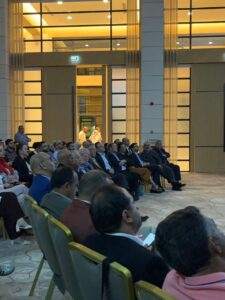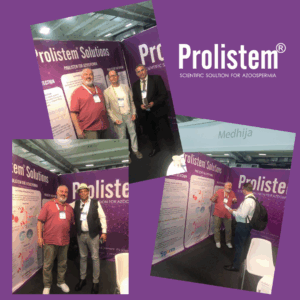
Male Infertility Symposium – Landmark Hotel, Amman
The Jordanian Society for Fertility and Genetics recently

Azoospermia is a medical condition characterized by the complete absence of sperm in a man’s ejaculate. It affects approximately 1% of the male population and up to 15% of men experiencing infertility. For many couples hoping to conceive naturally, azoospermia presents a heartbreaking barrier. However, recent advances in medical science have led to a breakthrough azoospermia cure that could transform the landscape of male infertility treatment.
In this blog post, we’ll explore the causes of azoospermia, traditional treatment options, and focus on the promising breakthroughs that offer fresh hope. Whether you or a loved one is facing this diagnosis, understanding the latest treatments can empower you to make informed decisions about your fertility journey.
Azoospermia means “no sperm” in the semen. It is diagnosed through a semen analysis, where the lab confirms the absence of sperm cells. There are two main types of azoospermia:
Obstructive Azoospermia (OA): This occurs when sperm production is normal but blocked due to an obstruction in the reproductive tract, such as vas deferens blockage or ejaculatory duct obstruction.
Non-Obstructive Azoospermia (NOA): This is due to impaired or absent sperm production in the testes, often linked to genetic issues, hormonal imbalances, or testicular damage.
Understanding which type of azoospermia is present is essential to determine the best course of treatment and evaluate the chances of successful sperm retrieval or cure.
The causes of azoospermia are diverse and often complex. Common factors include:
Genetic Disorders: Klinefelter syndrome, Y-chromosome microdeletions, and other chromosomal abnormalities can impair sperm production.
Hormonal Imbalance: Low levels of testosterone or pituitary gland dysfunction can reduce sperm generation.
Obstruction: Vasectomy, infections, trauma, or congenital absence of the vas deferens can block sperm transport.
Testicular Failure: Damage from chemotherapy, radiation, or infections like mumps orchitis.
Varicocele: Enlarged veins in the scrotum affecting testicular function.
Idiopathic Causes: In some men, no clear cause is found despite thorough investigation.
Historically, azoospermia treatment has been challenging, especially for non-obstructive cases. Traditional approaches include:
For obstructive azoospermia, microsurgical procedures such as vasovasostomy or vasoepididymostomy can restore the passage of sperm.
In cases caused by hormonal imbalances, medications like gonadotropins or clomiphene citrate can stimulate sperm production.
Techniques such as Testicular Sperm Extraction (TESE) or Microdissection TESE (micro-TESE) allow sperm retrieval directly from the testes for use in IVF or ICSI.
Despite these treatments, many men with azoospermia have limited options and often face uncertainty or failure in achieving biological fatherhood.
The good news is that recent advances in reproductive medicine and stem cell research are paving the way for a breakthrough azoospermia cure. These innovative approaches aim not just to retrieve sperm but to regenerate or induce sperm production itself.
Stem cell therapy is emerging as one of the most promising avenues. Researchers have discovered that certain stem cells can be coaxed to differentiate into sperm precursor cells. This could offer a regenerative cure for men with non-obstructive azoospermia.
How it works: Stem cells from the patient’s own body, such as mesenchymal stem cells (MSCs) harvested from bone marrow or adipose tissue, are injected or transplanted into the testes. These cells may help repair damaged tissue and stimulate new sperm production.
Current status: Clinical trials are ongoing, with some early success reported in animal models and pilot human studies. This approach could revolutionize azoospermia treatment within the next decade.
Genetic causes of azoospermia are notoriously difficult to treat. However, gene-editing technologies like CRISPR/Cas9 offer hope by potentially correcting mutations responsible for sperm production failure.
Though still in the experimental stage, gene therapy may offer personalized cures in the future for men with genetic azoospermia.
Refinements in micro-TESE and robotic-assisted sperm retrieval procedures improve success rates while minimizing testicular damage. This breakthrough in precision surgery enhances sperm recovery, especially in challenging cases.
New drugs targeting hormonal pathways and the testicular environment are under development. These aim to stimulate spermatogenesis more effectively than conventional hormone treatments.
To better understand azoospermia and the new cures, here are related terms often searched alongside:
Male infertility treatment breakthroughs
Stem cell therapy for azoospermia
Non-obstructive azoospermia cure
Micro-TESE success rates
Gene therapy for male infertility
Assisted reproductive technology for azoospermia
Hormonal treatments for azoospermia
Latest azoospermia research 2025
Early and accurate diagnosis is crucial. The diagnostic process includes:
Semen Analysis: Confirm absence of sperm. Multiple samples are recommended.
Hormone Testing: Assess levels of FSH, LH, testosterone, and prolactin.
Genetic Testing: Identify chromosomal abnormalities or Y-chromosome microdeletions.
Scrotal Ultrasound: Detect varicocele or testicular abnormalities.
Testicular Biopsy: In some cases, a biopsy determines the presence or absence of sperm production.
A diagnosis of azoospermia can cause significant emotional distress. Men and couples often face feelings of inadequacy, anxiety, and depression.
Counseling: Psychological support and counseling can improve coping strategies.
Support Groups: Connecting with others facing similar challenges can provide comfort and motivation.
While medical treatment is essential, certain lifestyle factors can impact male fertility and may complement treatment efforts:
Avoid smoking, excessive alcohol, and recreational drugs.
Maintain a healthy weight through diet and exercise.
Reduce stress through mindfulness and relaxation techniques.
Avoid exposure to environmental toxins and heat.
The future of azoospermia treatment looks promising with ongoing research into:
Artificial gametes: Lab-grown sperm cells from stem cells could bypass natural sperm production entirely.
Exosome therapy: Using tiny vesicles from stem cells to repair testicular tissue.
Improved ART protocols: Tailoring IVF/ICSI treatments based on azoospermia subtype.
The breakthrough azoospermia cure is no longer just a hopeful idea but a rapidly advancing reality. From stem cell therapies to gene editing and surgical innovations, the landscape of male infertility treatment is evolving. While some treatments are still experimental, many men today have renewed hope for biological fatherhood.
If you or someone you know is affected by azoospermia, consulting with a fertility specialist familiar with the latest advances is essential. Early diagnosis, appropriate treatment, and emotional support are key steps toward overcoming this challenging condition.
Q1: Is azoospermia curable?
Yes, depending on the type and cause, azoospermia can sometimes be treated or managed with advanced medical interventions.
Q2: How successful is stem cell therapy for azoospermia?
Currently, stem cell therapy is in clinical trials, but early results are promising for regenerating sperm production.
Q3: Can gene therapy cure genetic azoospermia?
Gene therapy is experimental but holds future potential for correcting genetic defects causing azoospermia.
Q4: What is the difference between obstructive and non-obstructive azoospermia?
Obstructive azoospermia results from a blockage preventing sperm release, while non-obstructive azoospermia is due to impaired sperm production.
Q5: What lifestyle changes can improve azoospermia treatment outcomes?
Healthy diet, exercise, avoiding toxins, and stress management can complement medical treatments.
American Society for Reproductive Medicine (ASRM) Guidelines
Recent Clinical Trials on Stem Cell Therapy for Male Infertility
National Institute of Child Health and Human Development (NICHD) Research Updates
Latest Publications on Male Infertility Gene Editing

The Jordanian Society for Fertility and Genetics recently

Prolistem for non obstructive azoospermia, Non-obstructive azoospermia (NOA)

Introduction Male infertility, especially caused by azoospermia, affects

We are proud to have participated in the